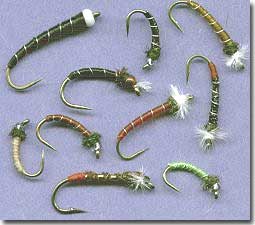Understanding Chironomids & How to Use Them
Understanding Chironomids & How to Use Them
By Vic Carrao
Chironomids undergo a complete metamorphosis, including a larva, pupa, and adult stage. Chironomids will live in the larva stage for up to two years before turning into pupa to begin their migration to the surface to hatch into adults. Trout feed on chironomid larva, pupa, and adults. However, chironomids are most often sought after by trout during the pupa's ascent to the surface. Chironomid hatches occur year round, and are usually the first and last hatches of the fishing season. The most intense chironomid hatches occur in May and June.
 The Chironomid ranges in length from five to twenty-five millimetres in the larva, pupa, and adult stage. The most prominent colors of the chironomid in the larva stage are yellow, tan, red, maroon, and brown. Best flies to represent the chironomid larva are thin and in sizes 16-8, in the colors mentioned. The pupa and adults come in a wide variety of colors including black, brown, olive, green, lime, red, maroon, gray, and orange. Pupa patterns should be thin and segmented, with white acrylic, white ostrich herl, white Z-lon or some other white material at the head to represent the gills.
The Chironomid ranges in length from five to twenty-five millimetres in the larva, pupa, and adult stage. The most prominent colors of the chironomid in the larva stage are yellow, tan, red, maroon, and brown. Best flies to represent the chironomid larva are thin and in sizes 16-8, in the colors mentioned. The pupa and adults come in a wide variety of colors including black, brown, olive, green, lime, red, maroon, gray, and orange. Pupa patterns should be thin and segmented, with white acrylic, white ostrich herl, white Z-lon or some other white material at the head to represent the gills.
Chironomid larva are found on or near the bottom of the lake. Therefore you should fish your chironomid larva pattern along the bottom. This is best accomplished with an intermediate sinking line, slow sinking line, or a floating line and long leader. Cast your fly out and allow it to sink to the bottom, then begin a slow hand twist retrieve. Often during periods of high winds, larva will be swept off the bottom and become vulnerable to trout. Trout will key in on these large schools of defenseless larva. You can imitate a chironomid larva being swept along by the current by casting out perpendicular to the wind and allowing your fly to dead drift down wind. No retrieve is required when using this method.
There are many different ways to fish chironomid pupa effectively. The most popular technique involves a floating line and a leader approximately the same length as the depth of water that you are fishing in. Cast your fly down wind from your anchored boat or float-tube and let your pupa pattern sink to the bottom. For this technique you may want to use a weighted pupa pattern so that you don't have to wait as long for the fly to reach the bottom. Once your fly is on the bottom begin an extremely slow hand twist retrieve. You may want to throw the very odd short quick strip in to draw attention to your fly. This slow hand twist retrieve will pull your fly up off the bottom and will imitate the chironomid pupa's slow ascent to the lake surface. Chironomid pupa fishing techniques requires a fast sinking line such as a Type 3 full sink. For this method cast your line out about as far as the depth of water that you are fishing, and let your line sink till it is completely vertical. Then use a slow hand twist retrieve to retrieve your fly. If you drag up weed, try not casting quite as far on your next cast. This method is best when fishing in water 20 feet or deeper. At times trout will key in on chironomid pupa caught in the surface film, or emerging chironomids. If this is the case, slide a very small piece of white foam down your line to the eye of your pupa pattern, or you can apply fly floatant to your leader.
Chironomids are available to trout throughout the open water season, and make up about 25% of a trouts diet. Any fly fisher who does not learn how to fish chironomids effectively will be severely limited in his/her possibilities.
|
